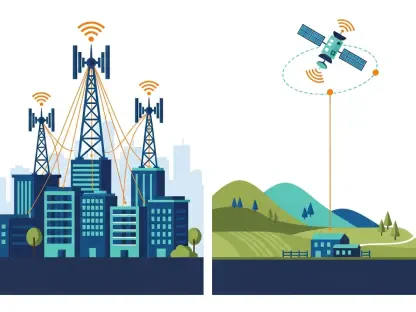In a landmark development in quantum communication technology, scientists have achieved a significant breakthrough by successfully transmitting quantum information over 155 miles of conventional fiber-optic cable without the need for cryogenic cooling. This milestone represents a critical step towards realizing the quantum internet, a revolutionary advancement poised to enhance digital communication and security through the unique properties of quantum mechanics. Documented in the scientific journal Nature, this advancement could fundamentally change the approach to digital networks, enabling lower-capacity devices to harness the computational power of quantum systems.
Landmark Achievement in Quantum Communication
The breakthrough in quantum communication underscores the importance of maintaining coherence over long distances, a feat previously achieved only under tightly controlled laboratory settings or through the use of expensive cryogenic cooling systems. The research, led by Mirko Pittaluga from Toshiba, demonstrated the transmission of quantum data, specifically qubits, over 155 miles of existing fiber-optic infrastructure. This achievement redefines the capabilities of conventional telecommunication networks, proving that quantum communication can be effectively integrated into the current fiber-optic infrastructure without the traditional necessity for near-absolute-zero temperatures.
The success of this experiment highlights the broader implications for future digital communication. By validating the practicality of maintaining coherence over long distances using standard fiber-optic cables, this breakthrough paves the way for the development of the quantum internet. The quantum internet promises to drastically improve cybersecurity by leveraging the inherent properties of quantum mechanics, such as the principle of superposition and entanglement, which offer unparalleled data encryption methods. Additionally, it holds the potential to revolutionize the connection and expansion of quantum computers, making their formidable processing capabilities more accessible and interconnected.
Practicality and Infrastructure Compatibility
One of the most striking aspects of this achievement is its reliance on conventional underground fiber-optic networks to transmit quantum data. This choice of infrastructure is significant as it demonstrates the compatibility of quantum communication with existing telecommunication networks, bypassing the need for specialized channels or modifications. Traditional cryogenic cooling, often essential to preserve the stability of quantum particles, was sidestepped, showcasing a more accessible and cost-effective approach to quantum data transmission.
This approach underscores the significance of advancing quantum communication technology through standard means. By utilizing commonly available fiber-optic cables, the team illustrated a practical pathway to scaling quantum networks. This milestone is crucial for deploying quantum internet on a broad scale, indicating that the existing infrastructure can support this advanced form of communication without necessitating massive overhauls or exorbitant investments in new technologies. This compatibility also alleviates some of the financial and logistical hurdles, making the widespread adoption of quantum communication more feasible.
Quantum Data and Qubit Stability
The transmission of quantum data involves the movement of qubits, the fundamental units of quantum information. Qubits are highly sensitive to environmental interactions and temperature fluctuations, making them prone to errors and data loss. Previous attempts to transmit qubits over long distances have typically relied on ultra-cold temperatures provided by cryogenic cooling to maintain stability and coherence. However, in this groundbreaking experiment, the researchers employed a novel approach that preserved the integrity and coherence of qubits across 155 miles of standard fiber-optic cable without such cooling measures.
This remarkable feat was achieved by employing techniques that mitigate the detrimental effects of environmental noise and temperature variations. The ability to maintain qubit coherence over long distances using conventional telecommunication infrastructure marks a significant step forward in the practicality of quantum communication. This advancement suggests that more stable and error-resistant qubits can be developed, facilitating robust and reliable quantum networks that can operate under everyday environmental conditions rather than controlled laboratory settings.
Perspectives and Expert Opinions
The importance of this breakthrough is echoed by industry experts who recognize its potential to revolutionize digital communication and cybersecurity. Mirko Pittaluga, who led the research team, hailed the achievement as a record due to the distance covered, the use of standard infrastructure, and the preservation of coherence. This validation of quantum coherence over extensive distances without cryogenic cooling is a testament to the feasibility of integrating quantum communication into existing networks.
Antia Lamas, director of the Quantum Networks Center at Amazon Web Services, further emphasized the potential implications of this advancement. She highlighted that the realization of the quantum internet could significantly enhance security by leveraging the unique properties of quantum mechanics to create virtually unbreakable encryption. Additionally, Lamas noted that the enhanced connectivity and capabilities of quantum computers facilitated by such networks would usher in new possibilities for computational power and problem-solving.
Real-World Application Feasibility
Reflecting on previous studies and practical demonstrations underscores the broader implications of this latest breakthrough. The current achievement sets itself apart by maintaining coherence under typical environmental conditions, a stark contrast to earlier experiments limited to controlled laboratory settings. This practical approach marks a substantial deviation, proving that quantum communication can thrive beyond meticulous and often impractical experimental environments.
The consistency of data integrity and transmission quality achieved in this experiment demonstrates that quantum communication can be extended beyond theoretical constructs into real-world applications. This shift towards practical implementation not only validates the scientific principles underpinning quantum communication but also lays the groundwork for future developments. As quantum communication protocols continue to evolve, the emphasis on real-world feasibility and environmental adaptability will become more pronounced, ensuring that these technologies can be seamlessly integrated into everyday digital communication frameworks.
Complementary Research and Studies
Additional research in the quantum communication sphere further exemplifies the rapid advancements in this field. A recent study by Shanghai Jiao Tong University, for instance, integrated encryption and communication through end-to-end deep learning (E2EDL), achieving secure transmission of 1 terabyte per second over 745 miles of optical fiber. This study highlights the ongoing progress and innovation driving the development of robust, high-capacity quantum networks that can operate on a large scale.
The complementary findings from various research initiatives create a collaborative landscape that accelerates the commercialization of quantum communication technologies. By showcasing different methodologies and applications, these studies collectively contribute to a more comprehensive understanding of the practical and theoretical challenges involved. The integration of robust security measures and high-capacity transmission capabilities illustrated by the Shanghai Jiao Tong study underscores the potential of quantum communication to redefine global data exchange paradigms.
Long-Distance Quantum Communication Practicality
The practical implications of integrating quantum communication within existing networks have been further validated by the expert consensus surrounding this milestone. Carlos Sabín from the Department of Theoretical Physics at the Autonomous University of Madrid commended the use of commercially available optical fiber without the need for advanced quantum communication technologies like cavities or cryogenics. This practical approach embodies a significant shift towards making long-distance quantum communication more feasible and scalable with current technologies.
Sabín’s insights highlight the practicality of utilizing photons generated by lasers, a robust and commercially available technology, to transmit quantum data. This pragmatic methodology underscores the viability of quantum data transmission without the reliance on complex and expensive setups. The broader acceptance and adoption of such practices suggest that quantum communication is inching closer to real-world applications, providing a solid foundation for the development of high-performance quantum networks that can operate within the constraints and capabilities of existing telecommunication infrastructures.
Future Prospects of Quantum Communication
In a groundbreaking advancement for quantum communication technology, scientists have managed to transmit quantum information over an impressive 155 miles of standard fiber-optic cable without requiring cryogenic cooling. This landmark achievement marks a vital step toward the development of the quantum internet, which promises to revolutionize digital communication and security, leveraging the distinctive characteristics of quantum mechanics. This innovation, detailed in the acclaimed scientific journal Nature, holds the potential to radically transform digital networks. It could allow lower-capacity devices to access and utilize the computational prowess of quantum systems. The quantum internet could not only enhance security features but also bring unparalleled efficiency to communication networks worldwide. By overcoming the need for cryogenic cooling, the researchers have paved the way for more practical and widespread implementations of quantum technology, ushering in a new era of advanced digital connectivity.









